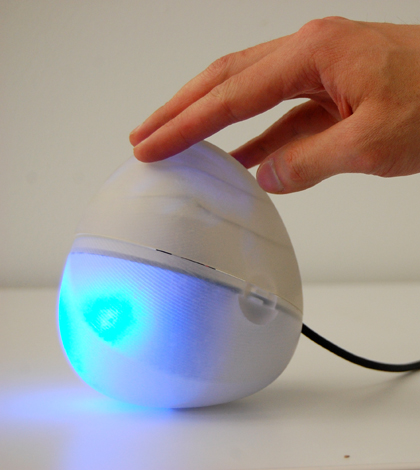Air Quality Egg shows power of open development

An openly developed air monitoring device in an egg-shaped package raises a question. Can science work at public demand, or do scientists determine what people need?
In the case of the Air Quality Egg, the public won the tug-of war.
From start to finish, the project has been completely open: Anyone could participate, anyone could draft ideas and anyone could fund the project.
A community effort composed of people across the world built the sensor using preexisting, open source technology. Most worked in their spare time, contributing whatever expertise or elbow grease they had.
The result was a sensor that collects air quality data outdoors coupled with an egg-shaped base station that stays indoors. The two communicate wirelessly and the base station transmits air quality data onto a free online database in real time. That’s all in a package that costs $185.
The project started when Ed Borden, the lead organizer, began engaging people through an online social network while working for a company called COSM, which enables tech startups. “As part of my role there I’d been building this in-person community using Meetup,” Borden said.
Meetup is an online social network that aims to get people face to face. Instead of chatting online about cats, or being 50 and single or even air quality, the site acts as a catalyst to get enthusiasts together in person.
Borden started a group called Sensemakers in 2010. In October of 2011 people started meeting in person. The project took off with meetings in New York City and Amsterdam to draft ideas, test and build the package. “Our goal was to put something out that was very active and could get people interested in this issue that affects all of us,” Borden said.
Borden said each meetup focused on certain decisions that needed to be made. For instance, the group had to decide how the package would look. Borden didn’t care about form. He just wanted it to get it onto the market quickly, but industrial designers in the group wouldn’t let that fly.
“I didn’t even want to make the egg shell,” Borden said. “I thought it was a waste of time and resources. I said, ‘Let’s put it in a freaking Tupperware box.’”
Incidentally, a video covering one meeting shows the sensor package installed in a small ice cream container obtained from a shop down the street from the gathering.
Preexisting technology enabled the Air Quality Egg’s quick development. The sensor package starts with an Arduino microprocessor designed for a variety of custom DIY computing needs. Developers then integrated coupled carbon monoxide, nitrogen dioxide, temperature and humidity sensors designed for the auto industry.
Once the group had a working prototype, they continued their open source methods by crowdsourcing funding to produce the Eggs. The group asked for $39,000 total to fund the project through a Kickstarter campaign. They hit their goal in five days and ended up with more than three times the requested amount when the 30 day campaign closed.
“I think it just says this is an issue that’s important to people and they want to be involved at some level.” Borden said.
The Air Quality Egg is now in production through a contributing company called Wicked Device. About 400 have been built and shipped to people across the world. A total of 1,200 were ordered so far.
Despite success and popularity of the egg, the speed and method of development and release limited its capability.
Borden unabashedly said he knows scientists would not consider the monitoring device accurate enough for their studies. He said the device only detects pollution when it gets to higher levels and does not pick up trace levels.
The package also can’t be calibrated. “Calibrating the sensor is something we didn’t know how to do at this price point,”Borden said.
Despite its low resolution and low accuracy, the sensor may provide some valuable information to average Joes, Janes and scientists alike. There is already a network of the sensors broadcasting information from countries across the world.
The data may not be the most accurate, but it may be enough to signal a need for further study in an area, or give its owners an inclination of whether or not to go running on a smoggy summer day. And, of course, there’s always room for more contribution and improvement from anyone interested.




Pingback: Sensors; making the invisible visible | Be Smart Now
Peter de Vries
June 14, 2013 at 4:40 am
I would suggest to get a Smart Citizen kit instead. They have more sensors, it is self-powered using a solar panel (included in the kit) and it is going viral now worldwide. I expect the Smart Citizen kit will have much more users worldwide in the coming months.
Get a Smart Citizen kit at http://www.smartcitizen.me or http://www.kickstarter.com/projects/acrobotic/the-smart-citizen-kit-crowdsourced-environmental-m/?ref=kicktraq